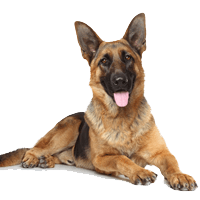
Avg Size of Female: Height: 22 – 24 inches, Weight: 75 – 95 pounds
Occasionally seen: Pancreatic insufficiency
Suggested tests: Hip, elbow, eye (blood)
Major concerns: CHD, elbow dysplasia
Note: GSDs are especially susceptible to a potentially fatal systemic fungal infection from Aspergillus.
Life span: 10 – 12 years
Minor concerns: Panosteitis, vWD, progressive posterior paresis, cauda equina, pyotraumatic dermatitis, skin allergies, malignant neoplasms, pannus, cataract, gastric torsion, perianal fistulas, cardiomyopathy
Avg Size of male: Height: 24 – 26 inches, Weight: 75 – 95 pounds
Brief History on German Shepherd Origin
While the original roots of this breed can be traced back as far as 7th century A.D. as a mountain sheepdog found in Germany, the true origination of the GSD we know today can be credited to Captain Max von Stephanitz. Sometime between the late 1800s and the early 1900s, Captain Max was the one who developed the German Shepherd into an all-purpose, useful working dog. Stories suggest that he used local shepherd dogs of the long-haired, short-haired, and wire-haired varieties. Which he had found in such places as Bavaria, Thurginia, and Wurtemburg. That combination resulted in the modern-day GSD we all know and love. The success of the German shepherd is attributed to an organization called the Verein fur Deutsche Scharferhunde SV. This group was working on developing a type of herding dog that would also be courageous, athletic, and intelligent. The dog became quite popular thanks to Hollywood’s creation of Rin Tin Tin and Strongheart, and the German shepherd enjoyed status as the top ranked breed in America for many years. Although this breed has since then lost a bit of popularity, it is still viewed as a versatile and hard-working breed whether it is used as a guard dog, in military work or a as a service dog.
German Shepherd Breed Appearance
The German Shepherd at first impressions is handsome, regal, and powerful. With a smooth outline, this breed is longer than it is tall, giving the appearance of an agile wolf-like build. The front legs are straight, while the thighs are very toned and well-muscled. Large, heavy feet feature well arched toes and thick, protective pads. The nails are generally dark in color and short. Chiseled and strong, the head is well-proportioned to the rest of the body. The almond shaped eyes are usually quite dark, but can range from a light orange/yellow brown, to a medium red brown, to black. The eyes offer an intelligent and interested expression. The ears usually stand up when they get close to one year old, and are held erect on the top of their head. The long muzzle features a black nose, strongly developed jaws with extremely powerful teeth that meet in a scissors bite. The neck is long and muscular, and leads to a straight and powerful back. The bushy, long tail hangs downward with a slight curve while the dog is at rest, and it raises and curves more definitively when the dog gets more active or excited. The gait is best described as a graceful, sure stride. This breed varies in color.
German Shepherd Breed Temperament
Considered to be one of the top breeds when it comes to intelligence, the GSD is notorious for its loyalty and ability to be trained. This dog adores its family and creates a huge bond with them, and is wary of strangers. Making it an excellent watchdog and guard dog as well as a wonderful companion. It only barks when it feels it is necessary to alert its family of something out of the ordinary, also when it is excited. Early and firm training will help to prevent the dog from becoming overly protective of personal items or developing any unwanted behaviors. It is generally very good with other pets and strange dogs if it is trained early on. Due to it’s naturally high prey drive, it must be socialized with non-canine pets at a young age to assure there will be no issues later down the line This breed is very good with children in its own family, but may not trust unfamiliar children that display unsure or erratic behaviors. Purchasing the dog from a reputable breeder is important, as some may be known to develop skittishness which might make them prone to fear biting in the future. The ability and want to learn is high in this particular breed, but coercive training is not a successful approach. A firm, positive hand is important to training a GSD. Because this dog truly enjoys being with its pack (or family), it should not be left alone for long periods of time.
German Shepherd Breed Maintenance
The double coat of the GSD requires regular brushing because it sheds bits of hair all year round. During shedding seasons, it sheds even more heavily. The coat should be brushed once or twice a week, unless extensive amounts of dog hair in the home is a problem which then a quick daily brushing is suggested. Bathing should happen rarely for this particular breed, ideally only once or twice a year to avoid the stripping of essential skin oils. The German Shepherd should be provided with mental and physical challenges on a daily basis. Consisting of exercise and learning games or consistent training lessons. This breed is primarily inactive when indoors, making it a well-behaved house dog. Although, time spent outside is important to prevent any frustrated or destructive behaviors. A large or medium sized yard to run and play in is ideal. An apartment dwelling is okay as long as sufficient exercise and mental activity is provided, such as long daily walks or more strenuous play while indoors. This breed is normally quite hardy and resilient, but can be prone to hip problems due to the way they were bred to be long yet low in the back end.
 Toledo, United States.
Toledo, United States.
